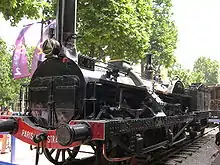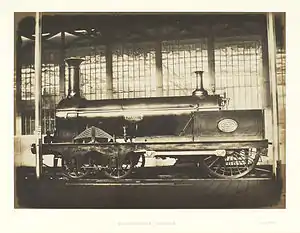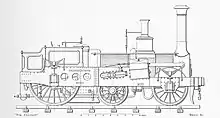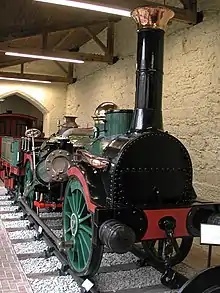Crampton locomotive
A Crampton locomotive is a type of steam locomotive designed by Thomas Russell Crampton and built by various firms from 1846. The main British builders were Tulk and Ley and Robert Stephenson and Company.

Notable features were a low boiler and large driving wheels. The crux of the Crampton patent was that the single driving axle was placed behind the firebox, so that the driving wheels could be very large. This helped to give this design a low centre of gravity, so that it did not require a very broad-gauge track to travel safely at high speeds. Its wheel arrangement was usually 4-2-0 or 6-2-0.
Design variations
Because the single driving axle was behind the firebox, Crampton locomotives usually had outside cylinders. However, some inside cylinder versions were built using indirect drive, then known as a jackshaft. The inside cylinders drove a crankshaft located in front of the firebox and the crankshaft was connected to the driving wheels by outside rods. Some long-wheelbase 0-4-0Ts were also built using this crankshaft system. The boiler feed-pump was often driven from the crankshaft as well because many Cramptons were built before the injector was invented.
Another peculiarity on some Crampton locomotives was the use of a boiler of oval cross-section, to lower the centre of gravity. It would nowadays be regarded as bad engineering practice because the internal pressure would tend to push the boiler into a circular cross-section and increase the risk of metal fatigue.
Usage

Crampton locomotives were used by some British railways and speeds of up to 120 km/h (75 mph) were achieved on the LNWR. They were more popular in France, southern Germany and the US. In France the expression "prendre la Crampton" meant to catch an express, and in the argot of the Saint Cyr military academy, footplate staff were known as "officiers de Crampton" (and this as late as 1971). One of the French examples has been preserved in the Cité du Train (the French Railway Museum) at Mulhouse and is still in working order. This is number 80 of the Chemin de Fer de l'Est, the Paris-Strasbourg line, which is named "Le Continent".
Locomotive list
The approximate numbers of Crampton-type locomotives built in Europe were:
- Great Britain: 51
- France: 127
- Germany: 135
Manufactured in Great Britain
Built by: Tulk and Ley, all of 4-2-0 wheel arrangement:
| Works no. | Date built | Railway | Name/no. | Notes |
|---|---|---|---|---|
| 10 | 1847 | Namur and Liege Railway | Namur | [lower-alpha 1] |
| 11 | 1847 | Namur and Liege Railway | Liege | [lower-alpha 1] |
| 1847 | Namur and Liege Railway | [lower-alpha 1] | ||
| 12? | 1847 | London and North Western Railway, Southern Division | 200 London | [lower-alpha 2][lower-alpha 3] |
| 14 | 1847 | Dundee and Perth and Aberdeen Junction Railway | Kinnaird | [lower-alpha 4] |
| 1847 | Sheffield, Ashton-under-Lyne and Manchester Railway | 35 Pegasus | ||
| 1848 | Sheffield, Ashton-under-Lyne and Manchester Railway | 36 Phlegon | ||
| 17 | 1854 | Maryport and Carlisle Railway | 12 | |
Notes:
- Namur was tested over 2,300 miles (3,700 km) on the LNWR[1] speeds up to 62 miles per hour (100 km/h) were recorded. Delivery of Namur, Liege and the third engine ordered for Belgium was delayed, and they were purchased by the South Eastern Railway in December 1849, becoming SER Nos 81, 83 and 85.
- Larger boiler and cylinders than Namur. Rebuilt as a goods 0-4-2 in 1855.[2][1]
- The LNWR obtained two other Crampton-type locomotives: Courier, 4-2-0, built at Crewe Works in 1847 and Liverpool, 6-2-0, built by Bury, Curtis, and Kennedy in 1848.
- the Dundee and Perth and Aberdeen Junction Railway was absorbed by the Scottish Central Railway in 1863.
Built by: Robert Stephenson and Company
Robert Stephenson and Company built a number of Crampton type locomotives for the South Eastern Railway and the London, Chatham and Dover Railway. These were all of 4-2-0 wheel arrangement with inside cylinders and indirect drive. The inside cylinders drove a crankshaft located in front of the firebox and the crankshaft was coupled to the driving wheels by outside rods.

| Works no. | Date built | Railway | No./Name | Notes |
|---|---|---|---|---|
| 785 | 1851 | South Eastern Railway | 134 | |
| 786 | 1851 | South Eastern Railway | 135 | |
| 787 | 1851 | South Eastern Railway | 136 Folkstone | [lower-alpha 1] |
| 788 | 1851 | South Eastern Railway | 137 | |
| 789 | 1851 | South Eastern Railway | 138 | |
| 790 | 1851 | South Eastern Railway | 139 | |
| 791 | 1851 | South Eastern Railway | 140 | |
| 792 | 1851 | South Eastern Railway | 141 | |
| 793 | 1851 | South Eastern Railway | 142 | |
| 794 | 1851 | South Eastern Railway | 143 | |
| 1851 | Prussian Eastern Railway | England[5] | ||
| 1851 | Prussian Eastern Railway | |||
| 1851 | Prussian Eastern Railway | |||
| 1851 | Prussian Eastern Railway | |||
| 1851 | Prussian Eastern Railway | |||
| 1851 | Prussian Eastern Railway | |||
| 1381 | 1862 | London, Chatham and Dover Railway | Coquette | [lower-alpha 2] |
| 1382 | 1862 | Echo | ||
| 1383 | 1862 | Flirt | ||
| 1384 | 1862 | Flora | ||
| 1385 | 1862 | Sylph | ||
Notes:
- The name should have read Folkestone but was misspelled on the plate. This locomotive was displayed at The Great Exhibition of 1851.[3] Bogie wheels 3 feet 6 inches (1.07 m) diameter, driving wheels 6 feet (1.83 m) diameter. Cylinders 15 by 22 inches (381 mm × 559 mm). Weight 26 long tons 5 cwt (58,800 lb or 26.7 t).[4]
- LCDR Echo class; rebuilt as conventional 4-4-0s in 1865–1866.[6] They were not given numbers until 1874.
Built by: Bury, Curtis, and Kennedy, all 4-2-0 except Liverpool which was 6-2-0.
| Works no. | Date built | Railway | No./Name | Notes |
|---|---|---|---|---|
| 355 | 1848 | London and North Western Railway, Southern Division | 245 Liverpool | [lower-alpha 1] |
| ? | 1848 | South Eastern Railway | 68 | |
| ? | 1848 | South Eastern Railway | 69 | |
| ? | 1848 | South Eastern Railway | 72 | |
| ? | 1848 | South Eastern Railway | 74 | |
| ? | 1848 | South Eastern Railway | 75 | |
| ? | 1848 | South Eastern Railway | 78 | |
Notes:
- Liverpool, 6-2-0, built by Bury, Curtis, and Kennedy works number 355 of 1848. Driving wheels 8 feet (2.44 m) diameter, grate area 21.5 square feet (2.00 m2), heating area 2,290 square feet (213 m2), boiler pressure 120 lbf/in2 (8.4 kgf/cm2; 830 kPa), cylinders 18 by 24 inches (457 mm × 610 mm). The locomotive was awarded a Gold Medal at the Great Exhibition of 1851.[1][7][2]
Built by: E. B. Wilson and Company
| Works no. | Date built | Railway | Name/no. | Notes |
|---|---|---|---|---|
| ? | 1847 | North British Railway | 55 | [lower-alpha 1] |
| ? | 1847 | Eastern Counties Railway | 108 | |
| ? | 1847 | Eastern Counties Railway | 109 | |
| ? | 1847 | Eastern Counties Railway | 110 | |
| ? | 1847 | Eastern Counties Railway | 111 | |
| ? | 1847 | Eastern Counties Railway | 112 | |
| ? | 1847 | Aberdeen Railway | 26 | |
| ? | 1847 | Aberdeen Railway | 27 | |
Notes:
- Hauled the Royal Train in 1850, withdrawn from service in 1907.[5]
Built by: R and W Hawthorn
| Manufacturer | Works no. | Date built | Railway | Name/no. | Notes |
|---|---|---|---|---|---|
| R and W Hawthorn | 1006 | 1858 | East Kent Railway | Lake | [lower-alpha 1] |
| R and W Hawthorn | 1007 | 1858 | East Kent Railway | Sondes | [lower-alpha 1] |
| R and W Hawthorn | 1008 | 1858 | East Kent Railway | Faversham | [lower-alpha 1] |
| R and W Hawthorn | 1009 | 1858 | East Kent Railway | Chatham | [lower-alpha 1] |
| R and W Hawthorn | 1010 | 1858 | East Kent Railway | Sittingbourne | [lower-alpha 1] |
| R and W Hawthorn | 1011 | 1858 | East Kent Railway | Crampton | [lower-alpha 1] |
Notes:
- LCDR Sondes class 4-4-0ST. Rebuilt by Kirtley as LCDR F class 2-4-0T in 1865.[8]
Built by: various builders


| Builder | Works no. | Date built | Railway | Name/no. | Notes |
|---|---|---|---|---|---|
| Nasmyth, Gaskell and Company | 53 | 1846 | South Eastern Railway | 92 | [lower-alpha 1] |
| LNWR Crewe Works | ? | 1847 | London and North Western Railway, Northern Division | 176 Courier | [10] |
| Kitson and Company | ? | 1848 | Midland Railway | 130 | |
| Kitson and Company | ? | 1848 | Midland Railway | 131 | |
| Timothy Hackworth | ? | 1848 | London, Brighton and South Coast Railway | 56 | |
| Timothy Hackworth | ? | 1848 | London, Brighton and South Coast Railway | 58 | |
| A. Horlock and Co | 1848 | Padarn Railway | Fire Queen | [lower-alpha 2] | |
| A. Horlock and Co | 1848 | Padarn Railway | Jenny Lind | [lower-alpha 2] | |
| R. B. Longridge and Company | ? | 1851 | Great Northern Railway | 200 | [lower-alpha 3] |
Notes:
- Originally built as a 2-2-2, rebuilt as a Crampton 2+2-2–0 December 1848.[9]
- 0-4-0 locomotives, 4 ft (1,219 mm) gauge, Fire Queen preserved at Penrhyn Castle Railway Museum. Jenny Lind named after the opera singer, a friend of Crampton's wife Louisa.
- Sources differ on how many Crampton locomotives Longridge built for the Great Northern Railway. Number 200 was later converted from a 4-2-0 to a conventional 2-2-2. There were nine similar 2-2-2 locomotives numbered 91-99 and it is uncertain whether these were built as 2-2-2 or whether they were converted from 4-2-0 like number 200.
Manufactured in France
Notes:
- First Crampton locomotives in France.[11]
- No. 80 Le Continent preserved in the Cité du Train.[12]
- Became PLM 1 to 12 from 1857.[14]
- Became PLM 13 to 18 from 1857.[14]
- Became PLM 19 to 30 from 1857. Sold to the Chemins de fer de l'Est in 1869 as their 601 to 612.[14][15]
- A 6-2-0 locomotive, converted to the Petiet system in the 1860s, withdrawn and scrapped in 1873.[16][11]
- Last of 30 locomotives built for the P-L between 1855 and 1857, plus 10 locomotives built for the PLM between in 1864.[18][19]
Manufactured in Germany
| Builder | Works no. | Date built | Railway | Name/no. | Notes |
|---|---|---|---|---|---|
| J. A. Maffei | ?–? (4) | 1853 | Pfälzische Eisenbahnen | 26 to 29 | [lower-alpha 1][lower-alpha 2] |
| Maschinenbau-Gesellschaft Karlsruhe | ?–? (2) | 1854 | Baden State Railway | 67 Adler and 68 Falke | [lower-alpha 3] |
| Maschinenbau-Gesellschaft Karlsruhe | ?–? (8) | 1854–56 | Baden State Railway | 69 Comet to 78 Basel | [lower-alpha 3] |
| Maschinenbau-Gesellschaft Karlsruhe | ?–? (8) | 1854–56 | Baden State Railway | 69 Adler to 78 Falke | [lower-alpha 3] |
| Maschinenfabrik Esslingen | ?–? (14) | 1855–63 | Pfälzische Eisenbahnen | 36–41, 46–49, 60–63 | [lower-alpha 1] |
| Ausbesserungswerk Karlsruhe | ?–? (3) | 1856 | Baden State Railway | 1, 2, and 4 | [lower-alpha 4] |
| J. A. Maffei | ?–? (12) | 1857–58 | Bayerische Ostbahn | A1 to A12 | [lower-alpha 5] |
| Maschinenbau-Gesellschaft Karlsruhe | ?–? (8) | 1858–59 | Baden State Railway | Rheinfelden to Pfalz | [lower-alpha 3] |
| Maschinenbau-Gesellschaft Karlsruhe | ?–? (8) | 1863 | Baden State Railway | Badenia to Offenburg | [lower-alpha 3][lower-alpha 6] |
Notes:
- Palatinate Railway 26 to 63.
- 1925-built replica of No. 28 Die Pfälz preserved in Neustadt/Weinstrasse Railway Museum.
- Baden IX class locomotives.
- Baden I c class locomotives.
- Bavarian B IX (Ostbahn). Rebuilt as 2-4-0 locomotives (1869–71)
- Phoenix of this series in service until 1903, length 12.90 metres (42 ft 4 in), top speed 120 kilometres per hour (75 mph), weight 28½ tonnes. Preserved in the Deutsches Bundesbahn Museum, Nuremberg.[20]
See also
- Long Boiler locomotive
- 6-2-0 for Crampton locomotives in the USA
References
- "London & North Western Railway locomotives: Introduction & pre-Ramsbottom". Steam Index. Retrieved 2008-03-22.
- Baxter 1978, p. 78.
- "Crampton's Locomotive Engine, displayed at The Great Exhibition 1851". The Royal Collection: Royal Palaces, Residences and Art Collection.
- "The South Eastern and Chatham Railway and the London, Chatham and Dover Railway Amalgamated 1899 LOCOMOTIVES: Their Description, History, distinctive features and interest". The Percy Whitlock Trust. Archived from the original on 2008-08-07. Retrieved 2008-03-22.
- "LOCOMOTIVES". Crampton Tower Museum. Archived from the original on 2008-02-04. Retrieved 2008-03-22.
- Bradley 1960, pp. 15–16.
- "Thomas Russell Crampton". Steam Index. Retrieved 2008-03-22.
- Bradley 1960, pp. 19–22.
- Bradley 1963, p. 43.
- Baxter 1978, p. 104.
- Davies 1997, p. 9.
- Davies 2001, p. 13.
- Davies 1997, p. 8.
- Davies 1996, p. 34.
- Davies 2001, p. 22.
- "Petiet's French Experiments". The Douglas Self Site. Archived from the original on 2010-10-18. Retrieved 2008-03-22.
- Davies 2001, pp. 15–16.
- "The Crampton steam locomotive". tgveurofrance.com. Retrieved 2008-03-22.
- Davies 1996, p. 57.
- "In the days when locomotives still had poetic names - the Phoenix". Deutsche Bahn Group. Archived from the original on 2008-01-16. Retrieved 2008-03-22.
Sources
- Baxter, Bertram (1978). Baxter, David (ed.). British Locomotive Catalogue 1825–1923, Volume 2A: London and North Western Railway and its constituent companies. Ashbourne, Derbyshire: Moorland Publishing Company. ISBN 0-903485-51-6.
- Bradley, D. L. (1960). The Locomotives of the London, Chatham and Dover Railway. Railway Correspondence and Travel Society.
- Bradley, D. L. (1963). The Locomotives of the South Eastern Railway. Railway Correspondence and Travel Society.
- Davies, John (July 2001). Chemins de fer de l’Est Locomotive List 1839–1938 (Third ed.). Woodbridge, Queensland: Dr. John Davies. ISBN 0-646-06600-5.
- Davies, John (January 1997). Chemins de fer du Nord Locomotive List 1842–1938. Sunnybank, Queensland: Dr. John Davies. ISBN 0-646-30938-2.
- Davies, John (1996). Chemins de fer P. L. M. and Constituents Locomotive List 1829–1938. Sunnybank, Queensland: Dr. John Davies. ISBN 0-646-15102-9.
- Sharman, M. (1983). The Crampton Locomotive. Oakwood Press. ISBN 0-9509067-0-0.